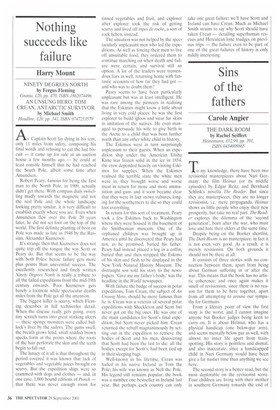Nothing succeeds like failure
Harry Mount
NINETY DEGREES NORTH by Fergus Fleming Granta, £20, pp. 470. ISBN 1862074496 AN UNSUNG HERO: TOM CREAN, ANTARCTIC SURVIVOR by Michael Smith Headline, £20, pp. 341, ISBN 0747253579 A, Captain Scott lay dying in his tent, only 11 miles from safety, composing his final words and refusing to eat the last biscuit — it came up for sale at an auction house a few months ago — he could at least console himself that he had reached the South Pole, albeit some time after Amundsen.
Robert Peary, famous for being the first man to the North Pole, in 1909, actually didn't get there. With compass dials swivelling madly towards the magnetic and not the real Pole and the whole landscape looking pretty similar, it is very difficult to establish exactly where you arc. Even when Amundsen flew over the Pole 20 years later, he did not set foot on the top of the world. The first definite planting of boot on Pole was made as late as 1948 by the Russian, Alexander Kuznetsov.
It's strange then that Kuznetsov does not quite trip off the tongue the way Scott or Peary do. But that seems to be the way with both Poles: heroic failure gets more plus points than uneventful success. The excellently researched and finely written Ninety Degrees North is really a tribute to all the failed expeditions from the mid-19th century onwards. Poor Kuznetsov gets barely a footnote while spectacular deaths miles from the Pole get all the attention.
The biggest killer is scurvy, which Fleming describes in full technicolor detail. When the disease really gets going, every tiny scratch turns into great stinking ulcers — these spongy monsters were called bullock's liver by the sailors. The gums swell, the breath grows fetid, small reddish brown specks form at the points where the roots of the hair perforate the skin and the teeth begin to fall out.
The lunacy of it all is that throughout the period covered it was known that lack of vegetables and vegetable juices brought on scurvy. But the expedition ships were so crammed with dogs and clothes — and, in one case, 1,000 bound editions of Punch — that there was never enough room for tinned vegetables and fruit, and explorer after explorer took the risk of getting scurvy and lived off tripes de roche, a sort of rock lichen, instead.
The situation was not helped by the spectacularly unpleasant men who led the expeditions. As well as forcing their men to live off unsuitable food, they ordered them to continue marching on when death and failure were certain, and survival still an option. A lot of the leaders were tremendous liars as well, returning home with fantastic accounts of how far they had got — and who was to doubt them?
Peary seems to have been particularly unpleasant but was at least intelligent. He was rare among the pioneers in realising that the Eskimos might know a little about living in very cold places: he was the first explorer to build igloos and wear fur skins in imitation of the natives. He even managed to persuade his wife to give birth in the Arctic to a child that was born further north than any other white child in history.
The Eskimos were in turn surprisingly unpleasant to their guests. When an expedition ship under the American Elisha Kane was frozen solid in the ice in 1854, the crew depended heavily on visiting Eskimos for supplies. When the Eskimos realised the terrible state the white men were in, they brought worse and worse meat in return for more and more ammunition and guns and it soon became clear that they were in fact snowy vultures, longing for the southerners to die so they could loot everything.
In return for this sort of treatment, Peary took a few Eskimos back to Washington where they were housed in the basement of the Smithsonian museum. One of the orphaned children was brought up in America until he discovered that Peary had not, as he promised, buried his father. Peary had instead placed a log in a coffin, buried that and then stripped the Eskimo of his skin and flesh to be displayed in the New York Natural History Museum. The distraught son sold his story to the newspapers. 'Give me my father's body,' was the headline in the World newspaper.
With failure the badge of success in polar expeditions. Tom Crean, the subject of An Unsung Hero, should be more famous than he is. Crean was a veteran of several polar expeditions with Shackleton and Scott but never got on the big ones. He was one of the main candidates for Scott's final expedition, but Scott never picked him. Crean returned the rebuff magnanimously by setting out in the expedition to retrieve the bodies of Scott and his men, discovering that Scott had been the last to die: all the bodies, except for Scott's, had been tied up in their sleeping bags.
Well-known in his lifetime, Crean was hailed in his native Ireland as Tom the Pole; his wife was known as Nell the Pole. His legend still remains popular: the book was a number one bestseller in Ireland last year. But perhaps each country can only
take one great failure: we'll have Scott and Ireland can have Crean. Much as Michael Smith strains to say why Scott should have
taken Crean detailing superhuman rescues and Herculean lone trudges on previous trips — the failure even to be part of one of the great failures of history is only mildly interesting.






































































 Previous page
Previous page